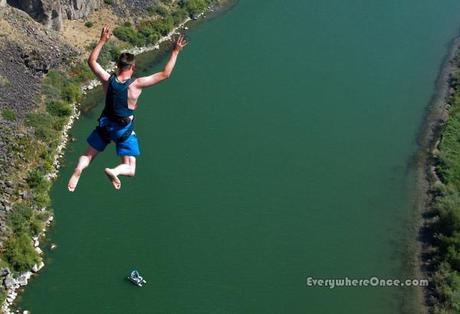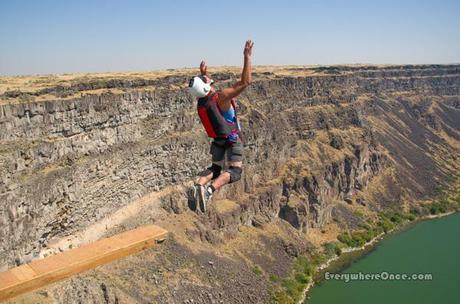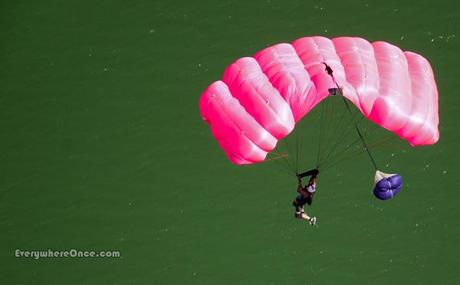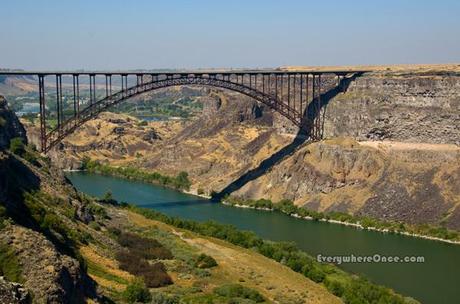
I walked across the expanse of the Perrine bridge in Twin Falls, Idaho, with the intention of photographing the beautiful gorge and the Snake River that serenely and quietly flowed some 500 feet beneath my shoes. What I never expected to see was someone jump from the bridge. Over the course of the next day, I watched a dozen or more people make that same leap.
As it turns out, Twin Falls is a prime destination for the adventure sport known as BASE jumping. Named for the things its participants choose to jump from (Buildings, Antennas, Spans, Earth) it is a form of low-altitude parachuting. And while it bears a striking resemblance to skydiving, it is – according to one Norway study – almost fifty times more dangerous.
In fact, one instructor we contacted required 200 solo skydive jumps before he’d even allow someone to take his BASE Jumping class. Ironically, that is because so much more can go wrong when jumping from 500 feet than from 5,000. One obvious difference is the shorter amount of time between jump and landing. It only takes a jumper in freefall about 5.6 seconds to hit the ground from 500 feet. That doesn’t provide a lot of time to correct a problem if one should arise. Many BASE Jumpers don’t even bother carrying a backup parachute because, well, why bother?
———————————————————————————————————–
“There are very few BASE jumpers with more than 500 jumps who have not spent serious time in the hospital due to BASE accidents. Most agree that it is just a matter of time until they are seriously injured. If you are not ready to die BASE jumping, you are not ready to go BASE jumping.”
–Snake River BASE Academy “Getting Into BASE”
———————————————————————————————————–
The limited time a BASE Jumper has to correct mistakes is compounded by their decreased capacity to do so. Freefalling people, like those who jump out of airplanes and off of bridges, need airflow over their bodies in order to maneuver and to stabilize themselves. Because BASE Jumpers typically spend less time in freefall than do skydivers, they top out at slower speeds resulting in less airflow and, therefore, less control. If a jumper can’t maneuver into proper position before deploying his parachute, lines can tangle and the chute may malfunction. Meanwhile a hard landing looms a few short seconds away.
Hitting the ground isn’t the only thing BASE Jumpers have to worry about. Jumping from fixed objects, like cliffs and buildings, carries the risk of smashing into those same objects on the way down. An unpredictable gust of wind can easily blow a jumper back toward those hazards. And releasing your parachute while out of position can mean gliding in an unintended direction – like directly into a cliff face.

Despite the risks folks still flock to this small section of Idaho Falls, a seemingly unlikely gathering place for adrenaline junkies. Flanked on one side by a traditional visitors’ center and on the other by a Best Buy parking lot, the Perrine Bridge gives the impression of a typical tourist attraction that has succumbed to the encroachment of suburban sprawl.
It’s an area where you’d expect to find a combination of sightseeing pensioners and soccer moms running errands. Mixed in with that crowd you also find something else: a high concentration of daredevils. They come here not for the shopping or for the view, but because the Perrine Bridge is perhaps the only place in the continental U.S. where BASE Jumping is always legal without a permit.
Most other places frown on the activity. The private enterprises that often own B.A.S.E.s suitable for jumping naturally fear the legal liability that comes with permitting such risky behavior on their property. Concerns about property damage and the nuisance factor also play a roll in limiting access to potential platforms.
So BASE Jumpers are forced mostly to pursue their sport underground, with a closely guarded list of prime – if illicit – jump sites. It’s likely that the unsanctioned sites only add to the renegade mystique of BASE Jumping and do more to encourage the kind of person attracted to this level of danger than to deter them.

But even renegades sometimes crave acceptance. When they do, they come to Twin Falls, an area where “there are no rules basically to ban BASE jumping,” says City Council Member Shawn Barigar. “As long as it is not disruptive, and isn’t causing any problems, more power to them. They are the ones taking the risk upon themselves.”
That Libertarian “live and let, um, live?” attitude has fostered a burgeoning BASE jumping community here. The local chamber of commerce promotes the activity to encourage tourism. Many local businesses give BASE jumping discounts and scores of instructors promote their qualifications to fledgling flyers.
Those inexperienced jumpers are drawn to the Perrine Bridge for more than just the permissive local attitude, though. With the canyon stretching 1,500 feet across and the bridge spanning that distance with a single arch, there is little for an errant jumper to injure herself on, other than the ground, of course. Even then, the slowly moving Snake River offers a somewhat softer landing spot for a jumper coming in too hot than the section of riverbank normally targeted for that purpose. As far as BASE jumping goes, the Perrine Bridge is like training wheels for Evil Knievel.

The Perrine Bridge in Twin Falls, Idaho, is ideal for BASE Jumping
In our short time there we watched both neophytes and veterans take the plunge. One instructor wheeled out a ten foot wooden plank that, once set up, jutted out perpendicularly from the bridge like the world’s highest diving board. He said it was to get his students as far away from the bridge as possible to minimize their chance of collision. We watched others who didn’t share that concern; some danced seemingly with carefree abandon along the bridge railing before tumbling over while another pushed off from a handstand position. One person even rode an inflatable whale, Major Kong style, all the way down.
And just like Major Kong, if you’re going to go, I guess you might as well go in style.

